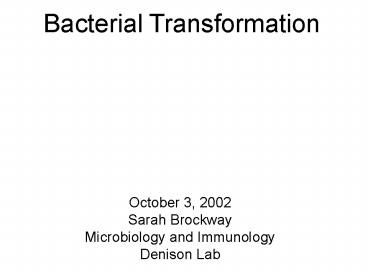Bacterial Transformation - PowerPoint PPT Presentation
1 / 13
Title:
Bacterial Transformation
Description:
The purpose of bacterial transformation is usually to amplify the plasmid DNA. ... Aliquot 10-100ul (amount varies based on transformation efficiency) of cell ... – PowerPoint PPT presentation
Number of Views:126
Avg rating:3.0/5.0
Title: Bacterial Transformation
1
Bacterial Transformation
October 3, 2002 Sarah Brockway Microbiology and
Immunology Denison Lab
2
Bacterial Transformation
- Introduction
- Aseptic technique
- Reagents
- Cell types
- Preparation of competent cells
- Heat-shock transformation
- Electroporation
- Plating on selective media
- Important tips
3
Introduction
- Bacterial transformation is the introduction of
a plasmid (circular DNA) into bacteria. - The purpose of bacterial transformation is
usually to amplify the plasmid DNA. - Plasmids can also to be introduced into bacteria
for protein expression purposes. - Heat-shock transformation and electroporation are
the two techniques commonly used.
4
Aseptic Technique
- Aseptic technique involves avoiding contact of
the bacterial cultures, sterile medium and
sterile surfaces of growth vessel with
contaminating organisms. - Always wash hands, wear gloves and work on a
clean surface. - Flaming the mouth of media bottles, tubes, loops,
cell spreaders, etc. will avoid contamination.
5
Reagents Needed
- Ice, pipettes, sterile tips, tubes
- Water bath (42ºC)and Shaker (37ºC)
- Cuvette and Electroporator
- Competent cells
- Plasmid DNA (ng amounts)
- Nutrient media luria broth (LB) or SOC
- Selective agar media (plates)
- Cell spreader or glass beads
6
Cell Types
- E. coli is a gram-negative bacteria used most
commonly for transformation. - Lab strains of E. coli are attenuated for
pathogenicity. - Common strains include
- -DH5?, BL21(heat-shock)
- -NM522, DH10B (electroporation)
- Cells can be purchased as competent or they can
be made competent with chemical treatment.
7
Prep of Competent Cells
- Chemically competent cells are prepared by
treatment CaCl2 which renders the cell able to
uptake DNA. - Electrically competent cells are prepared by
growth in low NaCl conditions. - Large scale preps are done, and aliquoted into
smaller amounts for future use. - Competent cells must kept on ice and stored at
-80ºC.
8
Heat-shock Transformation
- Thaw competent cells slowly on ice
- Add 200ng of plasmid DNA, or 20ul ligation mix,
to 50ul cells (amount varies) - Incubate on ice 20-30 min
- Incubate in a 42ºC water bath for 2 min to
shock cells (open pores to allow DNA access) - Place cells on ice for 2 min (closes pores and
begins recovery) - Add nutrient broth 1ml to cells
- Recover by shaking cells at 37ºC 1 hour to allow
the production of antibiotic resistance proteins
9
Electroporation
- Electroporation with high voltage makes
biomembranes transiently permeable to allow the
influx of DNA.
10
Electroporation
- Thaw cells and chill cuvette on ice
- Add 200ng (1ul) of plasmid DNA to 50ul cells,
transfer to cuvette, still on ice - Set electroporator to 2.5kV, 25uF and 200-400
ohms and put cuvette in place - Pulse cells briefly (10 msec)
- Immediately add nutrient broth 1ml to cells
- Recover by shaking cells at 37ºC 1 hour to allow
the production of antibiotic resistance proteins
11
Plating Cells
- After recovery period, pellet cells briefly and
resuspend in LB media - Aliquot 10-100ul (amount varies based on
transformation efficiency) of cell suspension
onto LB plates that contain appropriate
antibiotic - Spread cells evenly using sterile glass or
plastic spreader or glass beads - Allow excess liquid to absorb at room temp 15
min - Incubate plates at 37C upside down for 16 hours
- The goal is to get independent colony formation
12
Plating Cells
Glass rod
Agar plate with selective media
Formation of independent colonies
13
Important Tips
- Do not freeze-thaw cells numerous times
- Use proper controls, supercoil DNA, and no
insert controls for ligations - Be sure plates are less than 1 month old, and
were stored in the dark at 4ºC - Warm plates in 37ºC incubator to dry agar
surface - Incubate plates upside down to avoid
condensation drips - Do not incubate plates longer than 16 h, or
satellite colonies will form































